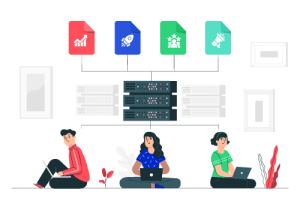How to Use Data to Drive Your Digital Marketing Decisions
In the world of digital marketing, data is a goldmine of insights waiting to be tapped into. Leveraging data can be the key to creating successful and effective marketing campaigns. In this article, we’ll explore how you can use data to drive your digital marketing decisions.
Table of Contents:
- The Power of Data-Driven Marketing
- Setting Clear Objectives
- Data Collection and Analysis
- Audience Segmentation
- Personalization Strategies
- Content Optimization
- Channel Selection
- A/B Testing
- Performance Measurement
- Iterative Improvement
Let’s dive into each of these aspects to understand how data can transform your digital marketing efforts.
1. The Power of Data-Driven Marketing
Why Data Matters
Data-driven marketing is the practice of making informed decisions based on data insights rather than relying on intuition or guesswork. It empowers marketers to create highly targeted and effective campaigns.
Data-driven marketing is not just a buzzword; it’s a fundamental shift in the way businesses approach their marketing efforts. Here’s why data is so essential in modern marketing:

1.1. Precision and Relevance
Data allows you to precisely target your audience with relevant content and offers. Instead of employing a one-size-fits-all approach, you can tailor your marketing messages to individual preferences and behaviors, increasing the chances of engagement and conversion.
1.2. Informed Decision-Making
Data provides the insights you need to make informed decisions. It eliminates guesswork and gut feelings, replacing them with concrete evidence of what works and what doesn’t. This evidence-based decision-making can significantly improve the efficiency and effectiveness of your marketing efforts.
1.3. Cost-Efficiency
Data-driven marketing can be more cost-efficient. By understanding which marketing channels and strategies yield the best results, you can allocate your budget more effectively, reducing wasteful spending and maximizing your return on investment (ROI).
1.4. Customer-Centric Approach
In the age of data, customer preferences take center stage. Collecting and analyzing data enables you to better understand your audience’s needs, desires, and pain points. This customer-centric approach fosters stronger relationships and builds trust.
1.5. Agility and Adaptability
The digital landscape is constantly evolving. Data-driven marketing allows you to stay agile and adapt to changing trends and customer behaviors. You can quickly adjust your strategies based on real-time data, ensuring that your marketing remains relevant.
1.6. Performance Measurement
Data provides a clear view of your marketing performance. You can track key performance indicators (KPIs) and metrics, such as website traffic, conversion rates, and customer engagement, to assess the success of your campaigns. This data-driven feedback loop enables continuous improvement.
1.7. Competitive Edge
Companies that embrace data-driven marketing often gain a competitive edge. They can identify opportunities and respond to market shifts more rapidly than those relying on traditional, less data-driven methods.
1.8. Enhanced Customer Experiences
By personalizing content and offers based on data insights, you can create more engaging and relevant customer experiences. This not only boosts satisfaction but also increases the likelihood of repeat business and brand loyalty.
In summary, the power of data-driven marketing lies in its ability to transform marketing from a hit-or-miss endeavor into a science. It empowers you to target your audience precisely, make informed decisions, optimize your budget, prioritize the customer experience, stay agile in a dynamic market, measure performance objectively, gain a competitive edge, and create personalized and engaging marketing campaigns. Embracing data-driven practices is no longer an option but a necessity for businesses aiming to thrive in the digital era.
2. Setting Clear Objectives
Define Your Goals
Before collecting data, set clear objectives for your marketing campaigns. Whether it’s increasing website traffic, boosting sales, or improving customer engagement, having specific goals helps you measure success.
3. Data Collection and Analysis
Collect Relevant Data
Gather data from various sources, including website analytics, social media platforms, email marketing, and customer databases. Analyze this data to gain valuable insights into user behavior, preferences, and demographics.
4. Audience Segmentation
Know Your Audience
Use data to segment your audience into distinct groups based on demographics, behavior, and preferences. Tailor your marketing messages and strategies to each segment for more personalized and relevant communication.
5. Personalization Strategies
Personalized Content
Leverage data to create personalized content experiences. Use customer data to recommend products, send personalized emails, or deliver content that speaks directly to individual interests.
6. Content Optimization
Data-Informed Content
Analyze data to understand which types of content perform best. Use this information to optimize your content strategy, focusing on the content formats and topics that resonate most with your audience.
7. Channel Selection
Effective Channel Use
Data can reveal which marketing channels are most effective for reaching your target audience. Allocate your resources to the channels that generate the highest return on investment.
8. A/B Testing
Experiment and Learn
Conduct A/B tests to compare different elements of your marketing campaigns, such as email subject lines, ad copy, or landing page designs. Data from these tests can guide you toward more effective strategies.
9. Performance Measurement
Track Key Metrics
Define key performance indicators (KPIs) that align with your marketing objectives. Regularly track and analyze these metrics to gauge the success of your campaigns.
10. Iterative Improvement
Continuous Enhancement
Use data insights to continuously improve your marketing strategies. Make data-driven adjustments to campaigns, content, and audience targeting for ongoing optimization.
In conclusion, data-driven marketing is a powerful approach that can transform your digital marketing efforts from guesswork into a science. By setting clear objectives, collecting and analyzing relevant data, segmenting your audience, personalizing content, optimizing your content and channels, conducting A/B tests, and measuring performance, you can make informed decisions that drive successful digital marketing campaigns. Embracing data-driven practices allows you to stay agile, adapt to changing customer preferences, and achieve better results in an ever-evolving digital landscape.






